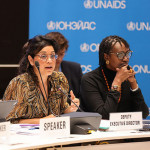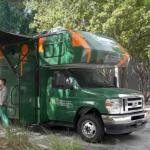 |
| Click here to read a digital edition of this article. |
Click here to watch video from the launch event.
Two Saturdays a month, I visit my hair salon, with its lime green walls and zebra-print accents, happily surrending my hair to my stylist. Not only does my hair thrive in her hands, but my soul flourishes, too. She is a friend who listens to me talk about my career goals, the devastating loss of a loved one, and every woman’s favorite topics: love and sex (not necessarily in that order). And, like any good friend, she wants to help me make the best choices for my hair and my health.
Given the power of the relationship and trust between stylist and client, it makes perfect sense that L’Oréal planned to leverage that connection to protect men and women across America from HIV/AIDS. And they did exactly that with the U.S. launch of the L’Oréal’s Hairdressers Against AIDS (HAA) campaign on World AIDS Day 2010 in New York City. HAA’s mission is to transform L’Oréal’s hairdressers into an army of advocates for AIDS prevention. The program integrates HIV/AIDS education into the training programs that every L’Oréal stylist must attend. The hope is—like the classic shampoo commercial—that L’Oréal’s stylists will take what they’ve learned back to their salons and tell their clients, who will tell two friends and they’ll tell two friends and so on and so on.
There are an estimated 1.2 million people living with HIV/AIDS in the United States; an estimated 56,000 more contract the virus each year. If a person sees a stylist as often as I do—24 times a year-—there is ample opportunity to get educated about the virus from a person you trust. Given the close relationship that often exists between client and clipper, it is more likely that people will take the prevention messages shared by their stylists to heart than if they get the same information from say, a public service announcement.
To get an idea of just how effective this campaign could be at reducing the spread of HIV in the United States, flip your hair around these numbers. Across the many L’Oréal brands in its professional products division, there are nearly 1,200 educators on staff. Besides working in the salons, these educators visit other salons, attend trade shows and train other hairdressers. Which translates into roughly 400,000 educational experiences in the United States each year. Furthermore, there are an estimated 950,000 full-time hairdressers in salons across the country who see 10 to 12 clients on average each day. It’s easy to see how one informative conversation about HIV prevention can lead to another—and so on, and so on—ultimately reaching millions of people across all social and economic backgrounds. L’Oréal’s goal is for its stateside stylists to reach 110 million Americans by World AIDS Day 2011.
 |
“L’Oréal’s initiative in the United States holds the promise of setting a new standard of scale and excellence—not just in public and employee engagement on HIV/AIDS, but on public and employee engagement period,” says John Tedstrom, president and CEO of the Global Business Coalition on HIV/AIDS, Tuberculosis and Malaria (GBC), which channels the expertise and resources of private-sector companies into initiatives to fight global epidemics.
Working with the L’Oréal Group and the United Nations, the GBC (of which L’Oréal is a member) played a huge role in the U.S. launch and offers continued support to the HAA campaign. The GBC worked with the Centers for Disease Control and Prevention (CDC) and the National Alliance of State and Territorial AIDS Directors (NASTAD) to ensure the information wielded by HAA stylists is up-to-date, accurate and in alignment with the CDC’s recommendations for HIV prevention and treatment. The campaign’s goals were based on the National AIDS Strategy: HAA aims to increase awareness and reduce risk by having conversations about the virus; get people to seek out the resources available to them for testing and care; and motivate people to talk about HIV with their loved ones. The intimacy of face-to-face encounters gives clients the chance to ask questions. And thanks to their extensive training, L’Oréal’s stylists are prepped with accurate answers.
“The campaign has tremendous impact potential because of its scale, because of its attention to smart messaging and [its ability] to drive people toward resources and testing and the like,” says John Newsome, former vice president of GBC’s U.S. HIV/AIDS Initiative. “I’m really proud of L’Oréal for their willingness to engage sometimes tough issues or exceedingly controversial issues that in reality should be addressed as matters of public health and basic humanity. Their embrace of condom promotion and anti-stigma messaging has been so powerful and exciting.”
The HAA initiative was born in 2001, when Lady Cristina Owen-Jones, a goodwill ambassador for the United Nations Educational, Scientific and Cultural Organization (UNESCO), shared how HIV/AIDS was taking a toll on people in South Africa with the executives at the L’Oréal Group. L’Oréal had a long-standing relationship with UNESCO, and a partnership was formed between L’Oréal’s SoftSheen-Carson brand and UNESCO to tackle the issue.
Since then, L’Oréal has launched the global prevention campaign in more than 30 countries—including France, Brazil, China, the United Kingdom, Italy, Germany and Spain. In total, it has reached 1.3 million hairdressers. Though it took almost a decade to launch the campaign stateside, it wasn’t because the company had forgotten about the state of the HIV epidemic in America. Rather, the corporation’s attention was diverted in recent years to numerous initiatives and acquisitions. “[But now] was the right time for us to truly mobilize an entire company in the best way possible [to fight AIDS in America],” explains Christine Schuster, senior vice president of worldwide education at Redken and Pureology, and the chair of Hairdressers Against AIDS USA. “[We now have] greater mass in terms of educators and people who can help as advocates for this program.”
On November 30, a group of 500 perfectly coiffed hairdressers gathered at the United Nations in New York City to launch the U.S. campaign. I was invited to join the L’Oréal stylists as they gathered for a campaign briefing. Watching the presentation, I caught the enthusiasm of the speakers as they talked about how L’Oréal’s stylists could make an enormous impact on their clients and maybe even save their lives. Feeling the visceral determination of this newly created army of AIDS warriors, I knew HAA wasn’t merely an edict handed down from corporate high—this was an initiative that each hairdresser personally embraced. Excitement filled the air. And that excitement was unleashed the next day, as stylists took HAA into the streets of New York in Harlem, Times Square and Lincoln Center on World AIDS Day.
The hairdressers’ goal was to have 1 million conversations about HIV on the streets of New York City—and to capture those conversations on Flip cameras to post online. The group of hairdressers I shadowed in Harlem educated people on the street about the virus—on one of the worst hair days in the history of World AIDS Days (I must say I was in desperate need of their services after surviving the torrential daylong downpour). But L’Oréal’s army was hardly discouraged by a little bad weather. They put on their rain ponchos, held up their red umbrellas, donned red scarves and marched down the street shouting: “Use your voice, use your power for a beautiful world without AIDS!”—the title of the stateside campaign.
“It was moving to feel their boundless enthusiasm, deep personal commitment and understanding that they were about to embark on the most meaningful of assignments, all on display at once,” Tedstrom says. “Not only does L’Oréal have the resources, expertise and organizational structures all positioned for breakthrough success, they have a secret weapon, an X factor, and that is the spirit of their team.”
HIV-positive stylist Tony DeSalvo was one of the 500 hairdressers. While he agreed the weather made it tough, he says getting people to take note was rewarding. “When you finally got someone to stop and make the video it was really great to see. Younger people were very open and willing to make a video with us,” says DeSalvo, who has been styling hair for 20 plus years.
After World AIDS Day 2010, DeSalvo returned to the Salon Republic in Beverly Hills, California. The minute he got back, his clients asked what he had been up to, so he had no trouble getting clients to start a dialogue about HIV—especially when he mentioned that people ages 13 to 29 account for 34 percent all new infections in the country. “That really makes people perk up and listen, [they say,] ‘Oh this isn’t about other people. This is possibly about my children,’” he says. All of his experiences talking with his clients about the virus have been positive, which he credits to great relationships and the bond he’s built with his clientele.
L’Oréal is aware that not every client is as open to dialogue as DeSalvo’s clients. After all, stigma and discrimination still abound regarding HIV. But now is a chance for a new beginning. As Schuster says, “It’s like we’re starting the conversation over again, a conversation that hasn’t been happening for quite a long time.”
And for those clients who aren’t comfortable talking about the subject, HAA materials are available, such as mirror decals for styling stations, magnets and informative leaflets that can be left at the reception desk or customer waiting area. The printed materials distinguish between the facts and myths about HIV, underscore the importance of regular HIV testing and explain ways to reduce risk. They also lead people to HAA’s website (hairdressersagainstaids.com) where visitors can locate more information, including local HIV testing sites (they can also follow the campaign on Twitter and Facebook).
This way, if some clients aren’t ready to talk about HIV/AIDS with their hairdressers, these materials will ensure that the topic can’t be swept under the rug along with their recently clipped split ends.






1 Comment
1 Comment